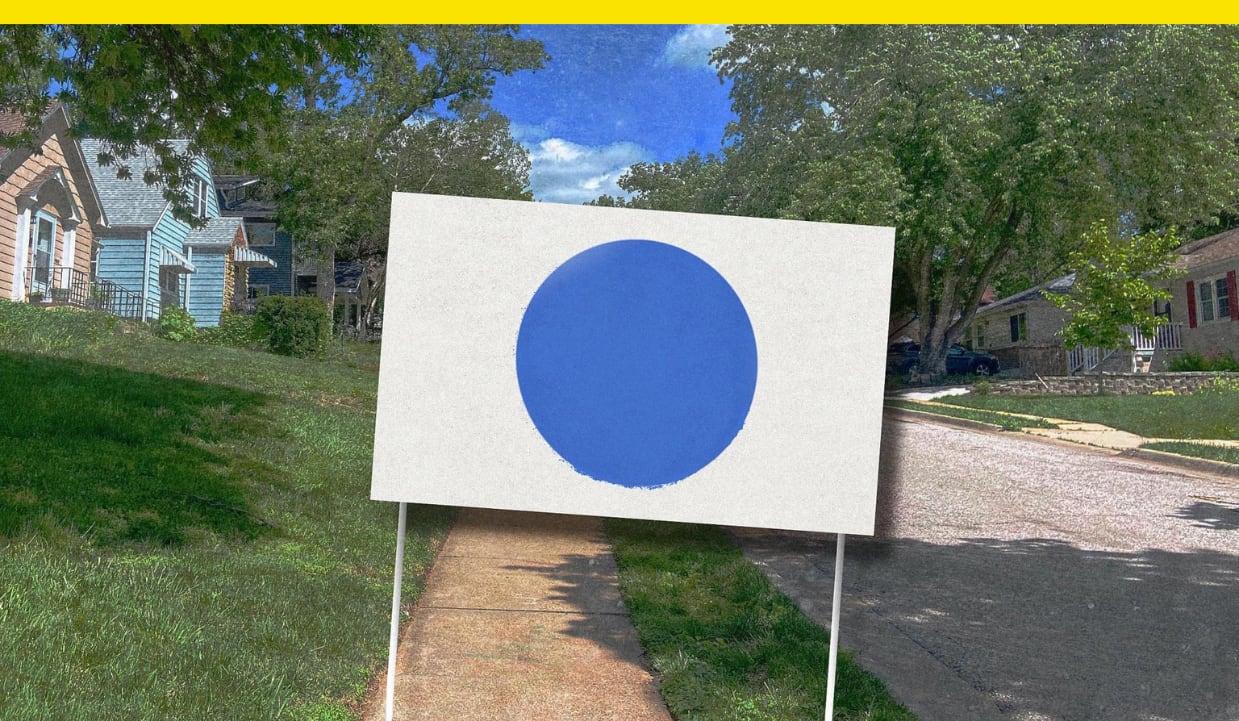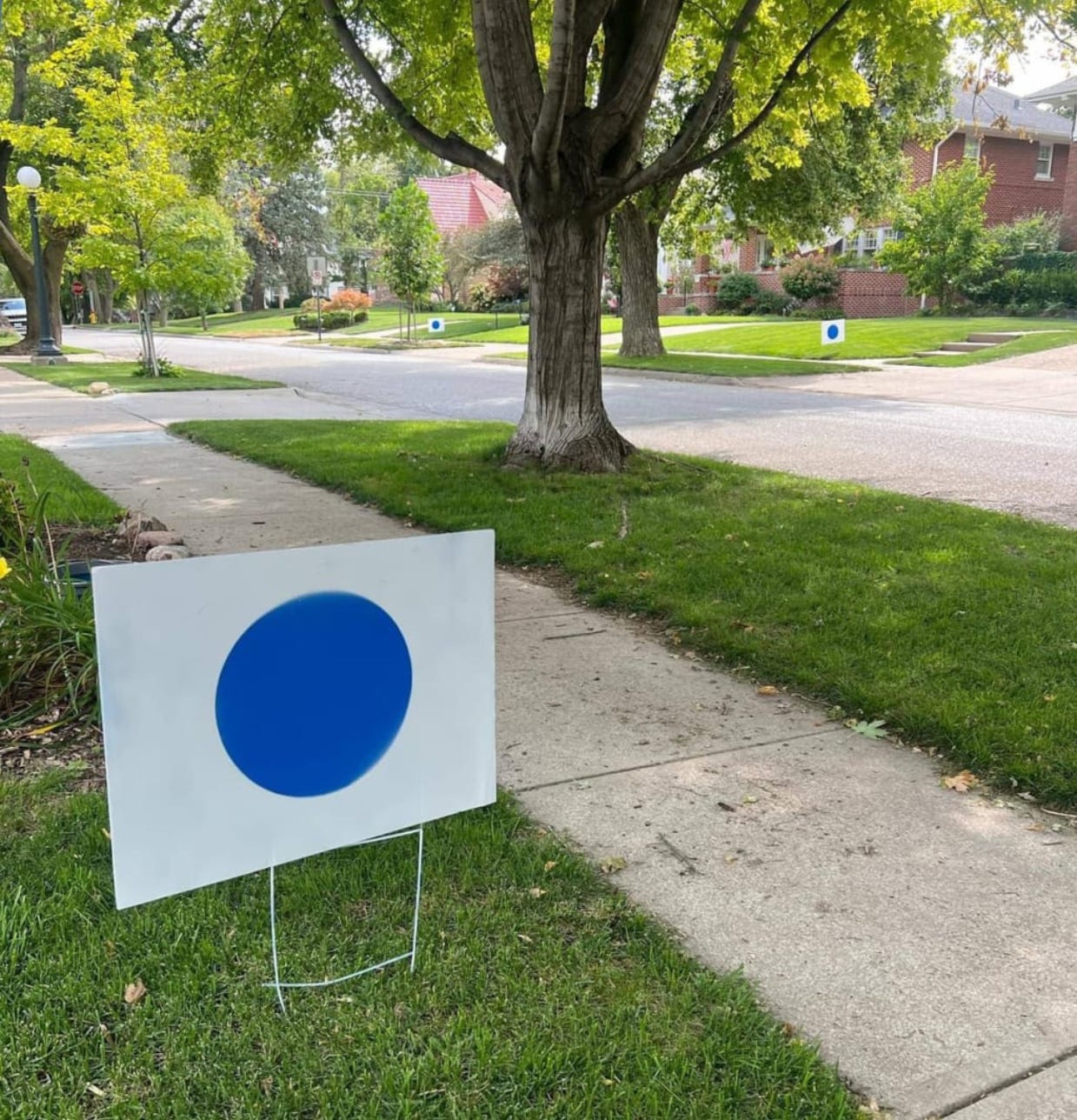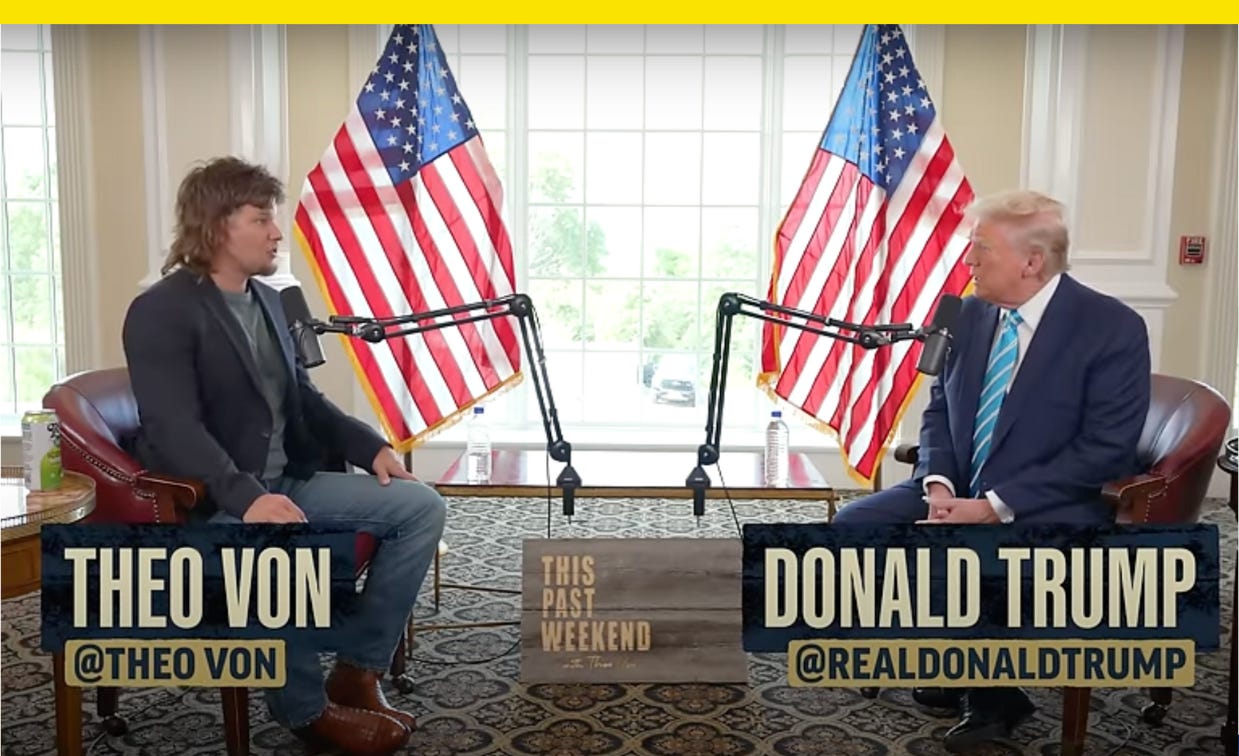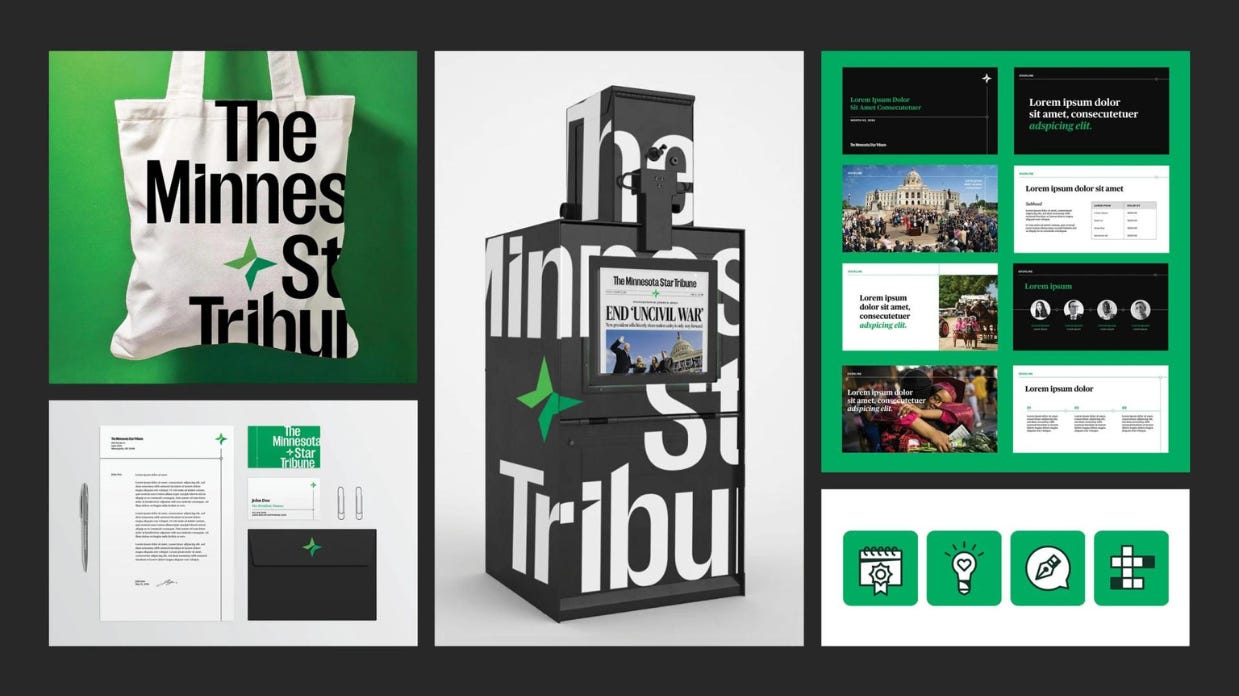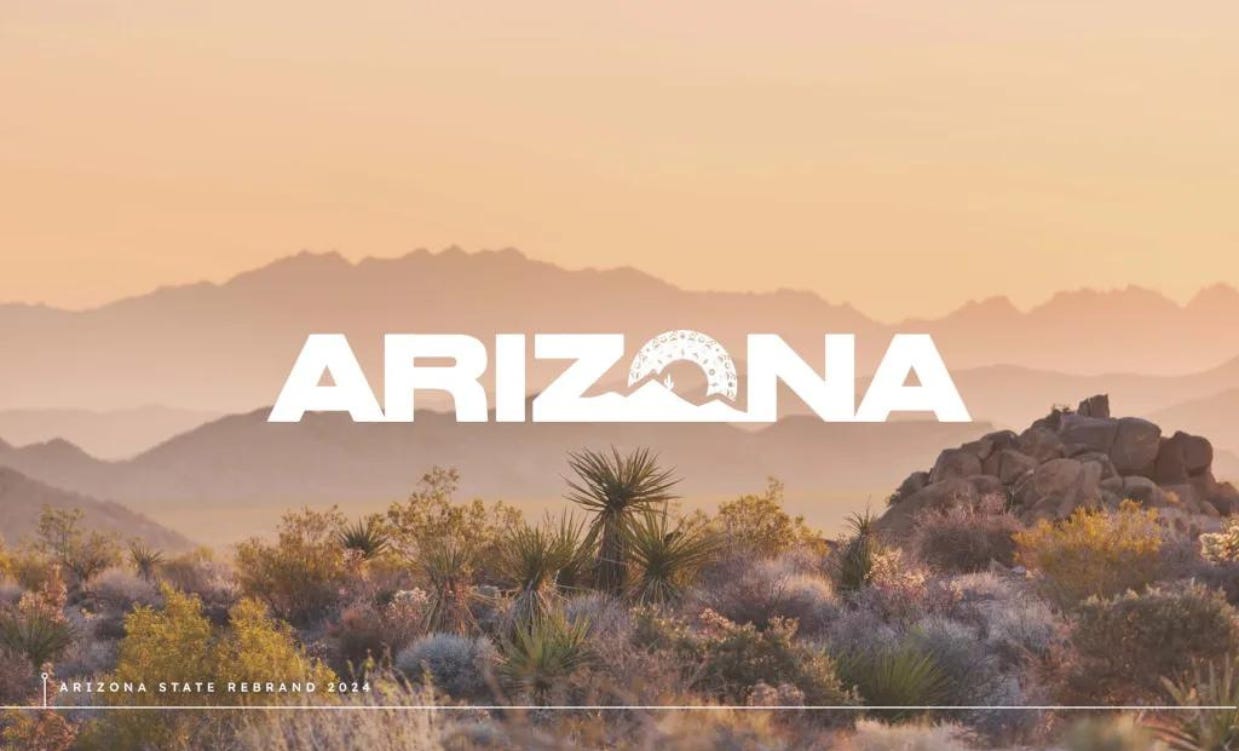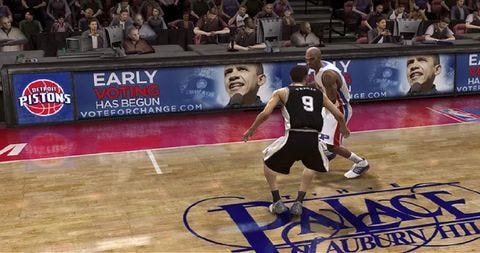This blue dot is popping up across Nebraska and it’s now a political symbol
Plus: Trump’s podcast strategy is honestly one of the smartest things he’s done
Hello, in this issue we’ll look at…
This blue dot is popping up across Nebraska and it’s now a political symbol
Trump’s podcast strategy is honestly one of the smartest things he’s done
Scroll to the end to see: how the Obama campaign reached young male voters in 2008 🎮
This blue dot is popping up across Nebraska and it’s now a political symbol
A single blue dot has become a political symbol in the solid red state of Nebraska.
About a week ago, Omaha resident Jason Brown painted a large blue dot on a white yard sign and put it up in the front yard of his and his wife Ruth Huebner-Brown’s home. The somewhat mysterious sign soon caught the attention of his neighbors in the swing district. Now, signs with the blue dot, which symbolizes a quirk in Nebraska electoral politics, are taking over Nebraska’s largest city as voters hope to turn the district blue for Vice President Kamala Harris.
What exactly is this electoral quirk? Nebraska is one of two states, along with Maine, that doesn’t award all its electoral votes in presidential elections as winner-take-all. Rather, Nebraska gives the statewide winner two votes and apportions the other votes by congressional district. That means voters in the more liberal Omaha area aren’t so much in a solidly “red” state as they are a potential “blue dot” inside that state. Should the election be tied, their one vote could determine the winner, and candidates like former President Barack Obama have campaigned there to win it.
Brown visualizes this distinction with his yard sign design—and his neighbors soon asked him to make them blue dot signs for their yards, too.
“The signs are truly conversation starters. The more of them there are the more conversations get started,” Grant Mussman, an Omaha man who is an administrator on the “Blue Dot Energy – Nebraskans for Harris-Walz” Facebook group, tells me. “We have been known as the blue dot since Obama,” he said, but adds that the yard sign idea “modernized it.”
The modernized concept also seems to have caused the signs to take off. Brown’s had so many requests, in fact, that he ran out of supplies after making 400 signs. He’s since ordered more materials to make an additional 1,600. The blue dot signs are now popping up in front of homes around town. Online, the Facebook group grows by about 1,000 members a day. One woman asked the group whether they’d ship signs to Florida.
Such an ambiguous symbol also means the signs can get around HOA regulations against yard signs with campaign logos. And luckily for Omaha Democrats who want a blue dot but can’t get their hands on one of Brown’s painted signs, they can always just make their own. One member of the Facebook group posted a photo of a blue dot window sign she said her nine-year-old made, and another said she left removable blue dot stickers for people to put on their mailboxes at a free little library in town.
Population density in the U.S. is closely correlated with political affiliation, meaning urban areas tend to be more liberal and rural areas tend to be more conservative. So while Democrats in Omaha might feel politically alone in their own state, voters in cities like Austin and Salt Lake feel their pain.
The resonance of the simple symbol speaks to how many Democratic-leaning voters feel in Republican-run states, but it’s taken hold in Nebraska because they can actually do something about it at the ballot box. Doing away with a winner-take-all method puts at least one electoral vote in Nebraska in play, and Mussman said many involved with blue dot signs “would like to see every state do it.”
Trump’s podcast strategy is honestly one of the smartest things he’s done
The 2024 presidential election will be the first since cable and broadcast television accounted for less than half of TV viewing. It’s a significant milestone for a technology that’s transformed campaign advertising going back 72 years to Dwight Eisenhower’s first-ever spot ads. For the first time since 1952, TV is no longer king. Former President Donald Trump, our nation’s second-ever president to enter politics following a career in television, has noticed.
“You win at that game [of politics] by getting the word out,” Trump said in a podcast episode with host Lex Fridman released last week, but, “it’s changed a lot in the last two, three years.” Television “could be less significant,” he said, “I don’t know,” while digital media, like his X Spaces with owner Elon Musk “got numbers like nobody’s ever heard before.”
Trump’s digitally focused press strategy — in the past month he’s done his Spaces with Musk, and podcast interviews with streamer Adin Ross, comedian Theo Von, and Fridman — is aimed at reaching young male voters his campaign believes he needs to win over to win the election. (A Trump interview with Joe Rogan seems unlikely, by the way. “I think he’s good at what he does but I don’t know about doing his podcast,” Trump told Fridman of Rogan. “I mean, I guess I’d do it, but I haven’t been asked and I’m not asking them.” OK, diva.)
Trump’s taking advice from his children for which podcasts to sit for. Ivanka Trump did an interview with Fridman first, in July, and Trump credited his son Barron for turning him onto Ross, signaling that the ex-POTUS who spent his time in office obsessively watching and complaining about cable news is curious about media diets other than his own.
“It's a different generation,” Trump told Daily Mail about his son’s media habits. “They don't grow up watching television the same way as we did. They grow up looking at the internet or watching a computer, right?”
Right. While the technology for podcasts is newer than television, the media strategy behind Trump’s podcast approach is tried and true. These are softball interviews, a digital-first equivalent to the late-night show interviews that Democrats currently enjoy but Trump has been banished from since his appearances on The Tonight Show and Saturday Night Live in 2016. Compared to Trump’s long, meandering rally speeches and confrontational interviews with news media, podcasts present a softer, more personable Trump.
The Pew Research Center found people ages 18 to 29 are the biggest age group among podcast listeners, perfectly suited to the Trump campaign’s strategy, and 46% of Republican and Republican-leaning listeners say they trust news they get from podcasts more than news they get from other sources, more than the 19% of Democrats and Democratic-leaning listeners who said the same thing.
Like late-night interviews, podcast interviews are a chance to reach people who don’t necessarily consume a lot of political news directly. The hosts Trump has sat with so far aren’t expressly political (though Von did have Sen. Bernie Sanders (I-Vt.) on his show a week before Trump; watch out Meet the Press), but they do reach a young, right-leaning, male audience of lower-propensity voters who might turn out for Trump if asked. With an intimate medium like podcasts, that ask has never had the potential to sound more inviting.
Have you seen this?
Right-wing influencers were duped to work for covert Russian operation, U.S. says. An indictment filed Wednesday alleges a media company linked to six conservative influencers was secretly funded by Russian state media employees to churn out English-language videos that were “often consistent” with the Kremlin’s “interest in amplifying U.S. domestic divisions in order to weaken U.S. opposition” to Russian interests, like its war in Ukraine. [Associated Press]
Minnesota’s biggest newspaper just rebranded itself. Is it enough to save local news? The ‘Minnesota Star Tribune’ just got a new logo, slogan, name, and design. [Fast Company]
Senate GOP campaign chair asks for more resources to win big battlegrounds. “I am concerned,” admitted Sen. Steve Daines (R-Mont.) during a roundtable with the press in Las Vegas. “We have more states in play than resources to cover them.” [NBC News]
“Everyone’s mad”: Inside crypto’s civil war over the 2024 elections. The cryptocurrency industry is exerting more sway than ever over U.S. politics. But behind the scenes, cracks are emerging between its left and right flanks over how to influence who will be president and control Congress next year. [Politico]
🔒 Arizona’s new logo captures the wonder of State 48. To design the new identity, the team behind the rebrand spent about 10 months interviewing more than 2,000 Arizonans statewide face-to-face, in digital meetings, and in surveys. [Yello]
History of political design
Obama campaign in-game video game ads (2008). Former President Barack Obama’s campaign was the first to buy in-game ad space in video games. The ads promoted early voting and appeared in nine sports and racing games put out by Electronic Arts Inc., including “Madden 09.” “It reaches an audience that is typically hard to reach — young males, roughly 18 to 34,” EA spokeswoman Holly Rockwood told NBC News about video games’ audience. Click through to see more screenshots.
A portion of this newsletter was first published in Fast Company.
Like what you see? Subscribe for more:
Politics in the front, pop culture in the back.
Subscribe to my new newsletter Whig:




